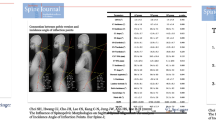Abstract
The sagittal pelvic morphology modulates the individual alignment of the spine. Anatomical angular parameters were described as follows: the “Pelvic Incidence” (PI) and the Jackson’s angle “Pelvic Lordosis” (PR-S1). Significant chains of relationships were expressed connecting these angles with pelvic and spinal positional parameters. This allows an individual assessment of the harmony of the sagittal spinal balance. But in case of spondylolysis with high-grade listhesis, the upper plate of the sacrum shows a dome-shaped deformity. The previous anatomical parameters are therefore imprecise. Indeed, the anterior part of the sacrum being inaccurate, an exact assessment of these angles becomes impossible. Therefore, we propose a new angular parameter named “Femoro-Sacral Posterior Angle” (FSPA): the angle between the posterior wall of the first sacral vertebra, always well definite, and the line connecting the posterior part of the sacral plate to the femoral axis. The validation of this parameter was performed and compared with the classical published parameters. It showed good inter-observer reliability, even with dome-shaped sacral plate. In spite of lower correlation with the positional parameters than those observed with PI or PR-S1, the FSPA appeared to be reliable and precise for an exact evaluation of the sagittal spino-pelvic balance is case of spondylo-listhesis with dome-shaped sacral endplate.


Similar content being viewed by others
References
During J, Goudfrooij H, Keesen W, Beeker TW, Crowe A (1985) Toward standards for posture. Postural characteristics of the lower back system in normal and pathologic conditions. Spine 10:83–87
Gardocki RJ, Watkins RG, Williams LA (2002) Measurements of lumbopelvic lordosis using the pelvic radius technique as it correlates with sagittal spinal balance and sacral translation. Spine 2:421–429
Guigui P, Levassor N, Rillardon L, Wodecki P, Cardinne L (2003) Valeur physiologique des paramètres pelviens et rachidiens de l’équilibre sagittal du rachis. Analyse d’une série de 250 volontaires. Rev Chir orthop 89:496–506
Hanson DS, Bridwell KH, Rhee JM, Lenke LG (2002) Correlation of pelvic incidence with low- and high-grade isthmic spondylolisthesis. Spine 27:2026–2029
Huang RP, Bohlman HH, Thompson GH, Poe-Kochert C (2003) Predictive value of pelvic incidence in progression of spondylolisthesis. Spine 28:2381–2385
Inoue H, Ohomori K, Miyasaka K (2002) Radiographic classification of L5 isthmic spondylolisthesis as adolescent or adult vertebral slip. Spine 27:831–838
Itoi E (1991) Roentgenographic analysis of posture in spinal osteoporotics. Spine 6:750–756
Jackson RP, Hales C (2000) Congruent spinopelvic alignment on standing lateral radiographs of adult volunteers. Spine 25:2808–2815
Jackson RP, Kanemura T, Kawakami N, Hales C (2000) Lumbopelvic lordosis and pelvic balance on repeated standing lateral radiographs of adult volunteers and untreated patients with constant low back pain. Spine 25:575–586
Jackson RP, McManus AC (1994) Radiographic analysis of sagittal plane alignment and balance in standing volunteers and patients with low back pain matched for age, sex, and size. A prospective controlled clinical study. Spine 19:1611–1618
Jackson RP, Peterson MD, McManus AC, Hales C (1998) Compensatory spinopelvic balance over the hip axis and better reliability in measuring lordosis to the pelvic radius on standing lateral radiographs of adult volunteers and patients. Spine 23:1750–1767
Jackson RP, Phipps T, Hales C, Surber J (2003) Pelvic lordosis and alignment in spondylolisthesis. Spine 28:151–160
Labelle H, Roussouly P, Berthonnaud E, Dimnet J, O’Brien M (2005) The importance of spino-pelvic balance in L5-s1 developmental spondylolisthesis: a review of pertinent radiologic measurements. Spine 30:S27–S34
Legaye J, Duval-Beaupere G, Hecquet J, Marty C (1998) Pelvic incidence: a fundamental pelvic parameter for three-dimensional regulation of spinal sagittal curves. Eur Spine J 7:99–103
Mac-Thiong JM, Berthonnaud E, Dimar JR II, Betz RR, Labelle H (2004) Sagittal alignment of the spine and pelvis during growth. Spine 29:1642–1647
Mangione P, Gomez D, Senegas J (1997) Study of the course of the incidence angle during growth. Eur Spine J 6:163–167
Marty C, Boisaubert B, Descamps H, Montigny JP, Hecquet J, Legaye J, Duval-Beaupere G (2002) The sagittal anatomy of the sacrum among young adults, infants, and spondylolisthesis patients. Eur Spine J 11:119–125
Osterman K, Osterman H (1996) Experimental lumbar spondylolisthesis in growing rabbits. Clin Orthop Relat Res 332:274–280
Roussouly P, Gollogly S, Berthonnaud E, Dimnet J (2005) Classification of the normal variation in the sagittal alignment of the human lumbar spine and pelvis in the standing position. Spine 30:346–353
Vaz G, Roussouly P, Berthonnaud E, Dimnet J (2002) Sagittal morphology and equilibrium of pelvis and spine. Eur Spine J 11:80–87
Vialle R, Levassor N, Rillardon L, Templier A, Skalli W, Guigui P (2005) Radiographic analysis of the sagittal alignment and balance of the spine in asymptomatic subjects. J Bone Joint Surg (Am) 87:260–267
Whitesides TE, Horton WC, Hutton WC, Hodges L (2005) Spondylolytic spondylolisthesis: a study of pelvic and lumbosacral parameters of possible etiologic effect in two genetically and geographically distinct groups with high occurrence. Spine 30:S12–S21
Yue WM, Brodner W, Gaines RW (2005) Abnormal spinal anatomy in 27 cases of surgically corrected spondyloptosis: proximal sacral endplate damage as a possible cause of spondyloptosis. Spine 30:S22–S26
Author information
Authors and Affiliations
Corresponding author
Rights and permissions
About this article
Cite this article
Legaye, J. The femoro-sacral posterior angle: an anatomical sagittal pelvic parameter usable with dome-shaped sacrum. Eur Spine J 16, 219–225 (2007). https://doi.org/10.1007/s00586-006-0090-3
Received:
Revised:
Accepted:
Published:
Issue Date:
DOI: https://doi.org/10.1007/s00586-006-0090-3




